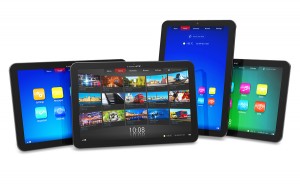Apple Inc. (NASDAQ:AAPL) is both one of the leading architects and main beneficiaries of the advance of tablet computers visible today.
With introduction of the much-prized iPad, the Cupertino, California company gave a heavy blow to the traditional desktop, whether running Windows or the various Mac operating systems. According to predictions by Gartner Analysts, a major research and advisory firm in the IT sector, tablet sales should exceed combined desktop and laptop computer sales by 2015, with 337 million units and 292 million units sold respectively.
In classic “chicken and egg” fashion, Apple Inc. (AAPL) is simultaneously prompting and perpetuating the tablet movement. This is not to say that tablets would not have become popular in the absence of Apple. If Steve Jobs’ company had never existed, the tablet would still have emerged as users and manufacturers sought to combine high levels of computing power with a maximally mobile chassis. However, the quality and popularity of the iPad has greatly accelerated the onrush of tablet technology and its swift overtaking of notebooks and desktops.
 An analysis by Needham in 2012 showed that PC growth is positive only in home computing (and barely there) and government. In business and education, two critical sectors, growth in Mac systems was powerful, while PCs slumped into strongly negative growth. The year over year fall of 165,000 units in PC purchases was attributed to the fact “that the iPad is beginning to cannibalize a material portion of PC sales.”
An analysis by Needham in 2012 showed that PC growth is positive only in home computing (and barely there) and government. In business and education, two critical sectors, growth in Mac systems was powerful, while PCs slumped into strongly negative growth. The year over year fall of 165,000 units in PC purchases was attributed to the fact “that the iPad is beginning to cannibalize a material portion of PC sales.”
2013 tablet sales roared ahead of previous-year totals, rising from 116.4 million units to 195.4 million units. Out of this, Apple captured a juicy 36% of market share with the iPad, moving 70.4 million units. Its closest competitor was Samsung, with 37.4 million units sold and 19% market share. An additional strength for Apple is that the iPad and the iPhone together form a functional mobile “electronics suite,” something much harder to put together reliably with the fragmented competing market.
One crucial measure which will play a role in Apple’s continued dominance in this sector is one that is difficult to quantify but has a powerful effect – brand loyalty. With the major entry of iPads into educational use around the world, the next generation of people will spend their childhoods using iPads and becoming used to iPads. These tablets will have the combined appeal of familiarity and nostalgia to the children of today when they become the adult of tomorrow, a type of brand loyalty which is likely to secure Apple’s success as a tablet seller for a generation.
As more tablets are bought, this will have a technological feedback effect. Purchases of these electronics products will prompt firms to put more money into R&D to improve the design. Greater memory, more flexible functionality, and other features will then continue to erode the advantages currently offered by desktops. At the same time, tablets will continue to offer their signature benefits of extreme portability and all-in-one convenience. Once they can match desktops for memory-heavy functions (such as graphics design and high-texture video games), the desktop will be functionally superfluous and will likely go extinct.
The transition from desktops and notebooks to advanced tablets is arguably the next stage in computer evolution. As the creator of the world’s single most successful tablet brand, the iPad, Apple Inc. (AAPL) is well-positioned to exploit it to the full. Though the process of swapping out an older technology (separate notebook and desktop computers) for the new (more powerful tablets) was inevitable, Apple has managed to place itself perfectly to cash in on the trend that it set in vigorous motion itself with the iPad’s release.
For more Apple news follow PFhub on FaceBook, Twitter or bookmark this page.



